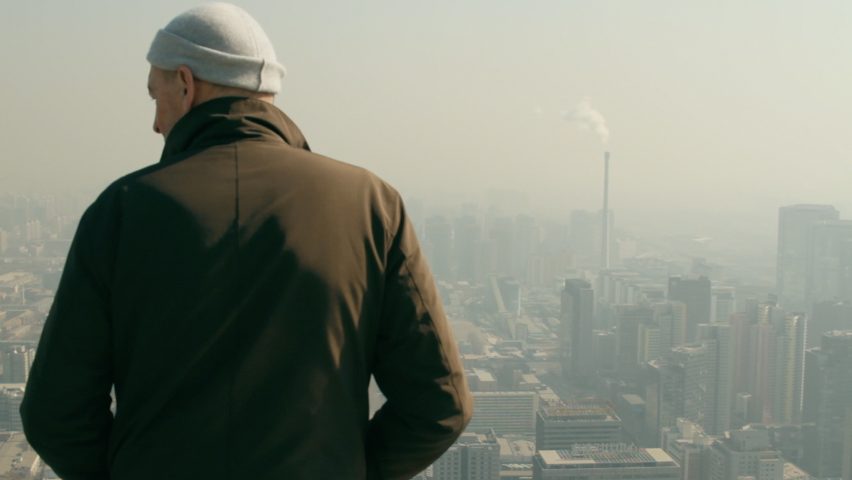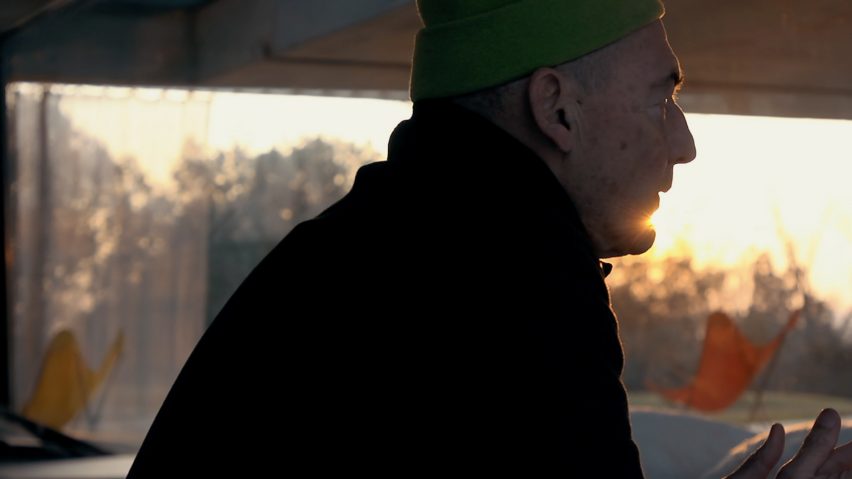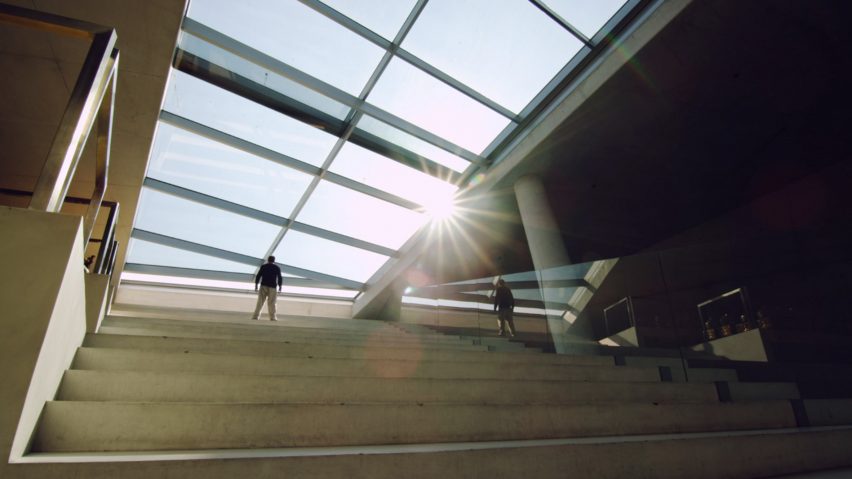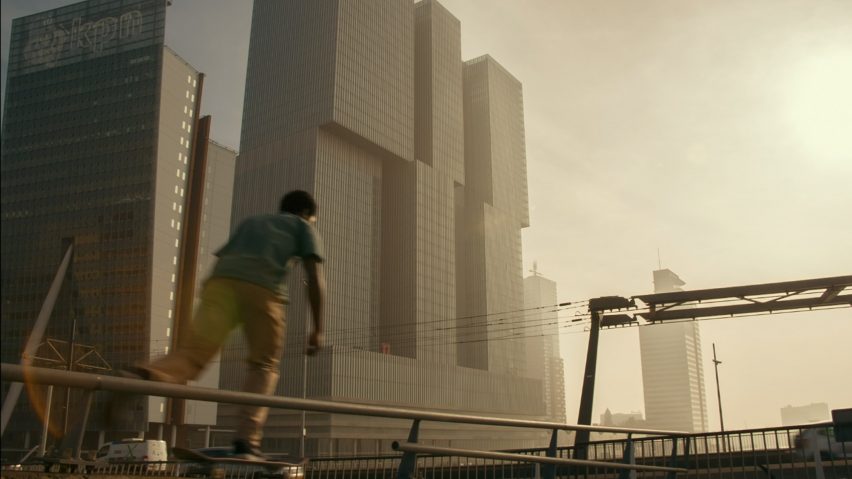
Rem Koolhaas "doesn’t respond well to having a lens shoved in his face" says his movie-maker son
Last autumn, Tomas Koolhaas released a film about his father, architect Rem Koolhaas. He spoke to Dezeen about the movie, their relationship and taking narrative tips from Kanye West.
Koolhaas junior, 36, spent four years following his father around the world to make the film called REM, which aims to capture the "human experience" of the architecture of OMA, the practice Koolhaas founded in 1975.
Koolhaas senior is filmed largely in profile or from behind throughout – an angle Tomas says was the result of trying to keep up with his father, but worked out as a happy coincidence, helping to achieving a more human perspective on his architecture.
"Rem is a fast walker and he's always got somewhere to be," said Tomas Koolhaas, speaking to Dezeen in late 2016. "He doesn't necessarily wait for you so I was a lot of the time running behind him, filming him from behind."
"That wasn't intentional but when I look back at the footage I thought this is an incredible angle, because you're seeing what he's seeing."

Koolhaas took some pointers from Kanye West's 2013 Yeezus tour for the film.
The tour, which was created by set designer Es Devlin, had strong religious overtones. Also, the rapper's face was masked during performances – an idea Koolhaas adopts in the film in an effort, he claims, to disentangle his father from his work.
"I went to see Kanye West's Yeezus tour – because I interviewed Kanye as well – and I thought it had a really cool effect. And later on when I spoke to him I found out that that was an intentional effect which was to take away that whole icon of fame, which is his face," he said.
For Koolhaas, this technique avoided the awkwardness of having to film his father's face in closeup for long periods of time.
"Ultimately what people start to idealise and worship and think about is this weird face," he said. "So as soon as you start making a film – and especially if you're someone's son and you're constantly filming their face – it gets to feel like, almost paparazzi-like, hero worshipping and I didn't want to do that."

Koolhaas references West's performance at Cannes Film Festival in 2012 – where the OMA-designed set allowed the artist's work to be screened from seven different perspectives.
"Rem being who he is doesn't necessarily respond well to having a lens shoved in his face, so you have to find a different way if you want him to be natural," added Koolhaas. "You have to find a more subtle way of doing it than just pointing a lens in his eyeball."
The 75-minute film, which premiered at the 73rd Venice Film Festival, revisits OMA projects the world over – from Nexus World Housing (1991) in Japan, to Maison à Bordeaux (1998) in France and Seattle Central Library (2004) in America.
It also features interviews with some of the partners heading up OMA's offices, including Shohei Shigematsu, who lead's the New York branch.

Tomas is based in LA but grew up in London, while Rem is primarily based in Holland. The filmmaker said the movie gave him a chance to spend time with his father.
"We don't often spend that much time together unless we have a reason do it," said Koolhaas. "We spent every day together filming and travelling and going everywhere together, and that was something that… it's almost unfortunate that we don't unless we have a specific reason."
"It was good that the film made us do that and I think it was good for both of us," he added.
Read a selection of highlights from the interview below:
Jessica Mairs: Why did you want to make REM?
Tomas Koolhaas: I feel like people have really missed what's most interesting, not necessarily about him [Rem Koolhaas] but about the way he thinks and about the way he approaches his work. When I see the films that are about him I never really saw anyone portray that or explore that in a meaningful way.
If you want to see intellectual information about buildings you can go on Wikipedia and you can go look on ArchDaily, Dezeen – that gives you all of the information you need – but then there's something else that can be explored and I think that was the point.
To watch my film and say "well it's not objective enough" – obviously it's not. I never thought of my subjective perspective as an issue, I embraced it and tried to use it to show people something that no-one else could see because if you went to film Rem then, nothing personal against you, but he just doesn't like to be filmed – especially by strangers.
I have an interesting perspective that's super intimate and hasn't been shown before
So he's going to shut himself down in a certain way and not reveal certain aspects, as soon as I'm filming him instead – someone who's always around him, someone who he's known for 36 years and someone he's comfortable with – I'm immediately going to capture something that they can't capture.
The fact I can be with him in all these different times and locations and situations and sort of moods is going to mean that I'm going to capture something that no-one else could physically capture because if you film him you're going to have one day in his office, maybe a couple of hours here and there, you'll have to fit into the schedule. I can follow him everywhere, I can film him swimming, I can film him in a hotel room, I can film him anywhere
I have an interesting perspective that's super intimate and hasn't been shown before. In the midst of all these human narratives that you see in the film, there's a human narrative going on that you will never see in the film, and most viewers would never guess – which is my human narrative, that I have had a long relationship with a lot of these buildings
Jessica Mairs: What did Rem think about you making the film?
Tomas Koolhaas: Well I mean Rem's a smart guy, he's a critical guy so he understands the potential pitfalls of any decision and as with anything else he weighs them up in a very tactical way. He understands that making a documentary with your son has numerous pitfalls, just in terms of working with your family, there is a risk in case something happens, there's some kind of conflict, the business relationship can interfere with the personal relationship.
Jessica Mairs: Has he watched it yet?
Tomas Koolhaas: He's seen parts of it but he hasn't watched the whole thing. It's not that important to either of us I think. Rem is involved in so many things that require him to either go insane or to give up control to other people, and to trust other people, that that's become his way of dealing with things.
Making the film, it wasn't really ever my goal to make him proud or that he's be happy about it.
Rem's a smart guy, he's a critical guy
Jessica Mairs: Has working on the film changed your relationship with Rem?
Tomas Koolhaas: He's been so busy doing his work and always in lots of different countries, I live in America and of course travel a lot and shoot in different countries. You don't often spend that much time together unless you have a reason do it, so we spent every day together filming and travelling and going everywhere together, and that was something that... it's almost unfortunate that you don't unless you have a specific reason. So it was good that the film made us do that and I think it was good for both of us. I don't think in any way it created any issues or any problems.
He was supportive because he gave his time and for someone as busy as Rem that's the most supportive thing that they could possibly do is to give you that tiny amount of time that they really don't have but they make time to give you that access and give you that interview
Jessica Mairs: What was it like growing up with Rem as your dad?
Tomas Koolhaas: What is it like to be the son of somebody else? I don't know so I have nothing to compare it to. All I can say is really my everyday life wasn't that different, also I was living in London and Rem was primarily in Holland so it's not a case where I was super involved with everything that was going on especially in terms of celebrity, and also people forget I'm 36, Rem hasn't had anywhere near the sort of celebrity that he has now for that long – only now when we go somewhere sometimes people recognise him and it's usually in Holland. In America, no-one recognise him unless you go into an architectural school.
Jessica Mairs: In the film, Rem talks about his complicated relationship with the media and fame.
Tomas Koolhaas: He's not very comfortable with the idea of fame but I think he has a healthy awareness of the necessity of modern world and the things that you have to do in order to achieve certain things, and especially now the way the media is, in order to achieve certain things you have to do certain things that you may not be comfortable with and I think he's very aware of that. He's willing to play the game with the media in order to be able to work on interesting projects that he wouldn't be able to work on otherwise.
He's not very comfortable with the idea of fame
Jessica Mairs: You never really see Rem's face in your film, only his profile or back. Can you tell me about that decision?
Tomas Koolhaas: There's deeper connotations to it about that whole fame thing that I don't want to just focus on his face.
I don't know if you're familiar with the Kanye West tour – The Yeezus Tour – he wore a mask through the whole tour. I went to see the tour because I interviewed Kanye as well and I thought it had a really cool effect, and later on when I spoke to him I found out that that was an intentional effect which was to take away that whole icon of fame, which is his face. Because ultimately that's what people start to idealise and worship and think about is this weird face, always the face.
So as soon as you start making a film and especially if your someone's son and you're constantly filming their face, it gets to feel almost paparazzi-like, hero worshipping. It's kind of weird putting people on a pedestal perspective of a starchitect and I didn't want to do that.
Also, Rem being who he is doesn't necessarily respond well to having a lens shoved in his face so you have to find a different way if you want him to be natural and you want him to reveal certain traits that he has, and certain sides to him – you have to find a more subtle way of doing it than just pointing a lens in his eyeball.
I also found the angle because Rem is a fast walker and he's always got somewhere to be, so he doesn't necessarily wait for you so originally I was a lot of the time running behind him, filming him from behind. That wasn't intentional but when I look back at the footage I thought this is an incredible angle because you're seeing what he's seeing. If I film Rem's face, you see Rem's face but what else do you see? You don't see what he's looking at, you don't experience what he's experiencing, you don't look at what's shaping how he sees things and how he thinks – that's what I want to see, that's what I'm interested in rather than just the face.